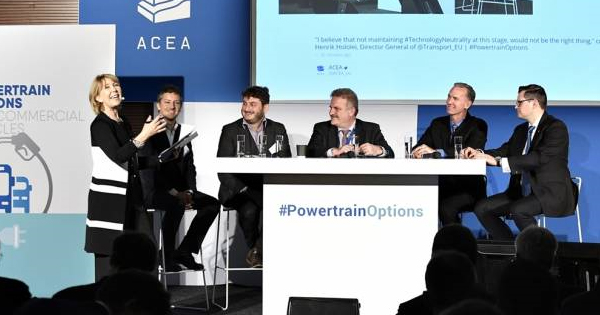In line with the objectives of the European Commission’s Mobility Package, the European Automobile Manufacturers’ Association (ACEA) held an event on Wednesday 29 November to explore the potential of the full range of powertrain options to contribute to further decarbonising road transport
The aim of the event – entitled ‘Powertrain options for commercial vehicles’ – was to explore the short-, mid- and long-term power choices for trucks, vans and buses. These can include conventional powertrains running on diesel or petrol – to alternative drives, running on biofuels, natural gas and hydrogen, as well as electric and hybrid-electric technologies.
It was a timely opportunity to have a discussion on this subject from the perspective of commercial vehicles, which are much more complex and diverse in terms of use-cases compared to passenger cars. For instance, as pointed out by Volker Mornhinweg, Executive Vice-President of Mercedes-Benz Vans and Chairman of ACEA’s Light Commercial Vehicle Committee, some policy makers “consider vans as passenger cars with big trunks – but this is certainly not the case”.
An issue debated by all present – including industry representatives, policy makers as well as the end-users of commercial vehicles – was why diesel powers well over 90% of all trucks, vans and buses on the roads today, and what it will take to increase the market uptake of alternatively-powered vehicles in the future.
Preston Feight, President of DAF Trucks and Chairman of ACEA’s Commercial Vehicle Board, shared three key policy recommendations with the audience, which counted some 235 people:
Infrastructure
“Truck drivers simply cannot be in a situation where they find themselves unable to recharge or refuel quickly and easily as they deliver goods from one country to another,” stated Mr Feight.
ACEA supports the Commission’s action plan for boosting investment in charging and refuelling stations throughout the EU. For all power choices, there needs to be adequate infrastructure available. This ranges in complexity from the continuation of low-sulphur diesel, to the availability of electrical charging stations, and compressed or liquefied natural gas fuelling stations. It even covers the capability of the electrical grid to cope with demand if high volumes of electrically-powered vehicles are introduced into the market.
Support structures
Feight said: “The affordability of alternatively-powered vehicles is key, as operators simply have to make money with their vehicles.” Taxation policies, incentives and public procurement can be useful tools to stimulate sales of alternatively-powered vehicles. But it is crucial that there is sufficient clarity, harmonisation and long-term stability in this regard.
Technology-neutral policies
Not every powertrain is ideal for all tasks, so it is not possible to designate a single technology for a particular vehicle, let alone an entire vehicle class. The choice should ultimately be commercially-determined by the end-user, based on his or her specific and unique needs, and the overall benefit to society. As ACEA Secretary General, Erik Jonnaert, summed up, “different transport needs require different transport solutions”. Policy must recognise and support this market-based approach.
With the right conditions in place, over time, ACEA believes that the market will see a stronger shift to alternatively-powered commercial vehicles, particularly in urban environments. Hakan Agnevall, President of Volvo Bus Corporation and Chairman of ACEA’s Bus and Coach Committee, stated: “Electrification is going to be one of the major ways forward in city transport, but not the only one.”
In parallel, the latest-generation of diesel technology – delivering low CO2 emissions and low real-world pollutant levels – will continue to be a powertrain of choice for many use-cases, such as the long-haul delivery of goods.
To bring the topic to life, 17 trucks, buses and vans, powered by different technologies, were put on display. Over lunch before the conference, Mr Feight, Mr Jonnaert, Mr Mornhinweg and Mr Agnevall led a group of policy makers from the European Commission, European Parliament, the permanent representations and the European Investment Bank on a tour of these vehicles, whose technologies were explained by representatives from each of the manufacturers.
#PowerTrucks, #Vans, #Buses

